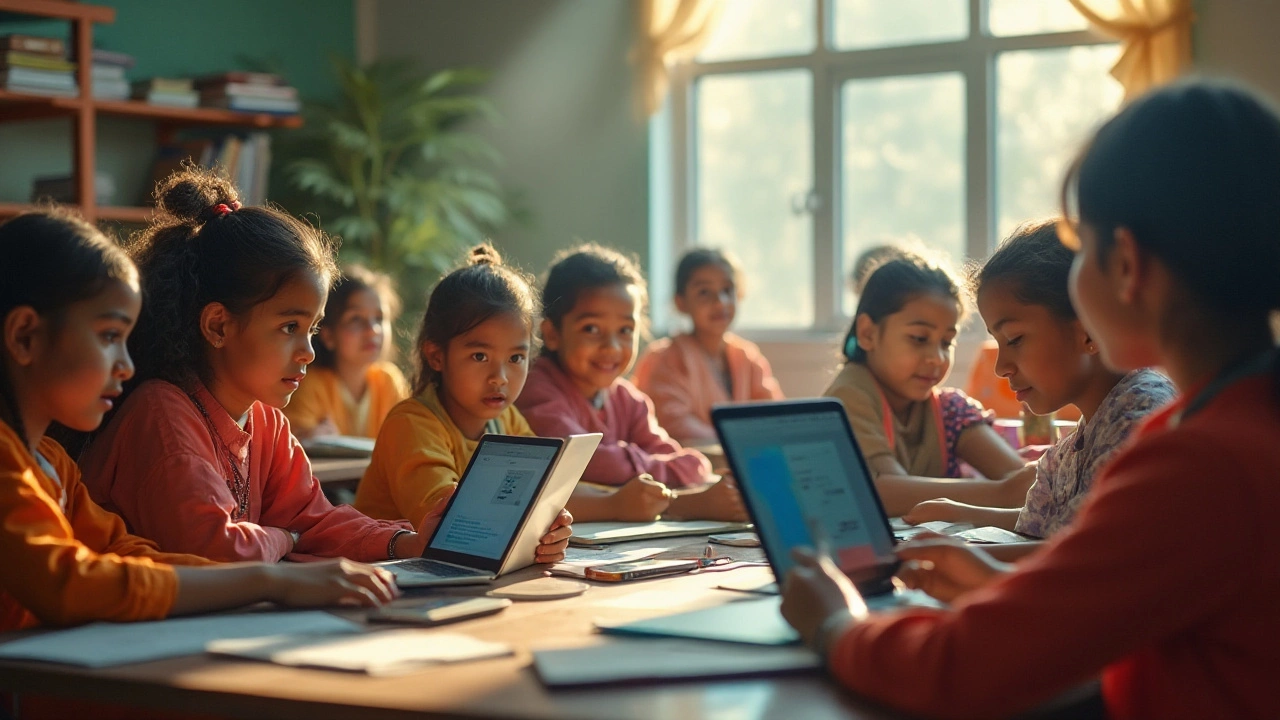In today's digital age, Google has evolved from being just a search engine to becoming a cornerstone in the field of digital learning. The opportunities it offers through various applications and platforms are transforming how we approach education and learning.
Google's suite of tools, like Google Classroom and Google Scholar, provides invaluable resources for students and teachers alike, supporting a wide range of educational activities. This article aims to delve into these resources and understand the profound impact Google has had on the e-learning landscape, offering tips to maximize its potential in various educational settings.
From organizing content for easy access to creating interactive learning environments, Google continues to pave the way for innovative educational advancements. Let's explore how this digital giant is reshaping the world of education.
- Google as a Learning Ecosystem
- Role of Google Classroom
- The Power of Google Scholar
- YouTube as an Educational Resource
- Integrating Google Tools in Teaching
- Future of E-learning with Google
Google as a Learning Ecosystem
Google has seamlessly integrated itself into our daily lives, acting as a gateway to information and a hub for education. This giant of a digital platform provides a diverse array of tools that serve both educators and students. At the heart of this ecosystem is the ambition to democratize knowledge, making it accessible to anyone with an internet connection.
The various applications under the Google ecosystem cater to different educational needs. For instance, Google Classroom has revolutionized the way teachers distribute assignments, provide feedback, and maintain communication with their students. This tool not only streamlines administrative tasks but also provides a collaborative space where learning can continue beyond the physical classroom. The beauty of it lies in its simplicity, ensuring that teachers and students can use it without extensive training.
Beyond administrative tasks, Google offers platforms like Google Scholar, which is an invaluable resource for researchers and students. It allows users to access scholarly articles, theses, books, and conference papers, broadening the horizons for learners and educators alike. Users can explore a multitude of research fields, fostering a culture of self-driven learning. Also, Google Scholar keeps researchers up to date with the latest advancements by providing notifications about new publications in their fields of interest.
Google’s vast reach doesn't stop there. YouTube, another part of the Google family, has emerged as an essential resource for visual and auditory learners. Channels dedicated to education, such as TED-Ed or Khan Academy, provide free content that supports curriculum and fosters curiosity. By incorporating visual storytelling and expert insights, these resources enhance understanding and retention of complex concepts. In fact, a study found that students who use video clips as part of their study routine show a 9% improvement in understanding intricate subjects.
"Technology can become the 'wings' that will allow the educational world to fly farther and faster than ever before—if we will allow it," says Jenny Arledge, an educational consultant committed to enhancing learning through technology.
In considering what makes Google an incomparable learning ecosystem, the emphasis on connectivity and integration is key. The ecosystem supports an open exchange of knowledge and fosters innovative education methods. With tools that integrate seamlessly into existing systems, Google is not just a collection of applications—it's an engaging learning experience. The beauty of Google’s ecosystem is that it empowers both teachers and students by providing them with the resources, they need to excel in the digital era. Whether it's through collaboration, research, or multimedia learning, Google is undeniably a pivotal player in the e-learning field.
Role of Google Classroom
Google Classroom has transformed the landscape of modern education by providing a versatile and user-friendly platform that bridges the gap between traditional teaching methods and the digital world. As a part of Google's suite of applications, it offers a host of features designed to facilitate classroom management and enhance the learning experience for both educators and students. By enabling educators to distribute assignments, provide feedback, and communicate with students all in one place, Google Classroom empowers teachers to create more efficient and organized educational environments.
The beauty of Google Classroom lies in its simplicity. Teachers can easily set up a course, invite students, and share resources without the need for complicated IT support. This ease of use allows educators to focus on teaching rather than managing technology. The platform supports integration with other Google tools like Google Drive, Docs, Sheets, and Slides, making it a comprehensive ecosystem for schools that adopt it. This integration simplifies the sharing of resources and knowledge while significantly reducing the time required for administrative tasks.
Another significant advantage of Google Classroom is its adaptability to different teaching methodologies. Whether a teacher prefers flipped classrooms, blended learning, or entirely virtual classrooms, Google Classroom provides the tools necessary to support these teaching strategies. Its features like quizzes, assignments, and discussion boards encourage collaborative learning, keeping students engaged and motivated. Google Classroom also supports inclusivity, accommodating students with different learning needs and allowing them to access resources at their own pace.
During the recent surge in online education, especially during the pandemic, Google Classroom showcased its potential on a global scale. Schools worldwide implemented it to ensure education continuity, emphasizing the need for robust digital learning platforms in crisis situations. In fact, as of 2021, approximately 150 million students, educators, and school leaders were actively using Google Workspace for Education, which includes Google Classroom. This statistic underscores the platform's role as a crucial element in the current educational landscape.
When discussing the impact of Google Classroom, one cannot ignore the feedback from educators who have adopted this platform. According to a statement by a leading educator:
"Google Classroom has allowed me to streamline my teaching process and focus more on individual student needs. It has changed the way we interact in a classroom setting, even if that classroom is virtual."This sentiment is echoed in many teaching communities where increased engagement and improved student-teacher communication are cited as key benefits.
Looking towards the future, the role of Google Classroom will only become more pivotal as education continues to evolve. With ongoing enhancements and updates, the platform aims to meet the dynamic demands of digital education. It promises to equip educators with progressive tools necessary to nurture young minds and foster a culture of inclusive and innovative learning. Whether used as a standalone solution or integrated with other digital tools, Google Classroom remains a valuable asset in the portfolio of any modern educator.

YouTube as an Educational Resource
YouTube is an extraordinary educational asset that revolutionizes the very concept of learning, crossing traditional boundaries of classrooms. It is not merely a platform for entertainment; with its vast repository of videos, it has become a second classroom for millions worldwide. Students and educators alike find it a valuable tool for enhancing their knowledge in various subjects. Free access to lectures from renowned universities, DIY tutorials, language learning, and more makes YouTube an educational haven. Notably, its power lies in the ability to cater to diverse learning styles — whether a student prefers visual, auditory, or kinesthetic modes, YouTube presents the necessary avenues to fulfill these needs, making learning more engaging and effective.
One of the key aspects that set YouTube apart as a powerful learning tool is its accessibility. With just an internet connection, learners across the globe can access an endless supply of educational content. For instance, famous educational channels like Khan Academy and CrashCourse have democratized learning, offering high-quality, free lessons to anyone with internet access. Not only do these channels break down complex subjects into digestible parts, but they also apply engaging methods to maintain the learner's attention. In areas lacking educational resources, YouTube stands as a beacon of opportunity, providing knowledge and skills without geographical constraints.
Moreover, YouTube fosters a sense of community through its interactive features. The comment sections act as virtual classrooms where learners and educators can interact, share insights, and pose questions. This communal learning environment enriches the education experience, making it collaborative rather than solitary. For educators, YouTube provides a platform to expand their reach, allowing them to impact a global audience. As a student from any corner of the world can leave a comment or question, it opens pathways for global perspectives and discussion.
"Learning is not the product of teaching. Learning is the product of the activity of learners," said John Holt, emphasizing the importance of active learning, an approach that YouTube strongly supports through its diverse content.
Another key feature of YouTube's educational utility is its capability to offer learning at one's pace and convenience. Unlike traditional classroom settings where the pace is often dictated by the instructor, YouTube allows users to pause, rewind, and revisit content multiple times until they grasp the concept. This individualized pace is crucial for those who may need extra time to understand certain subjects. YouTube also supports closed captioning and translations, accommodating learners with hearing impairments or those who speak different languages, thus broadening its accessibility.
Looking at the statistics, nearly 500 hours of content are uploaded every minute on YouTube, a testament to its inexhaustible resources. Out of this, a significant portion is educational material that ranges across topics and disciplines. The impact of these resources is profound, assisting students with assignments, professionals enhancing their knowledge, or hobbyists learning a new skill. A 2023 survey indicated that over 70% of users considered YouTube their primary source for learning new things, a clear indicator of its value in modern education.
Integrating Google Tools in Teaching
Incorporating Google tools into teaching practices opens up a multitude of pathways for enhancing instructional methods and fostering student engagement. When an educator utilizes platforms such as Google Classroom, Google Docs, and Google Meet, they can create a seamless extension of the traditional classroom. This integration not only enriches the learning experience but also aligns with the digital-first approach that modern education demands. For instance, Google Classroom provides a virtual space where assignments, announcements, and feedback can be shared effortlessly, encouraging continuous communication and collaboration between teachers and students.
E-learning platforms like Google Classroom act as a hub where educational content is easily accessible, thus streamlining the process of submitting and grading assignments. As more educational institutions embrace hybrid models of learning, the ability to upload teaching materials, conduct quizzes, and track student progress online becomes essential. Teachers can use Google Forms for creating interactive surveys and quizzes, which offer instant assessment feedback that can help in identifying areas where students might be struggling. This real-time data allows for immediate intervention, tailoring instruction to meet the needs of each learner effectively.
Another powerful tool in the Google arsenal is Google Docs, renowned for its collaborative features. Students can work together on projects, share ideas, and provide peer feedback, all within the same document. This breaks the traditional barriers of classroom walls, fostering a community of practice that extends beyond school hours. The automatic saving feature ensures no work is lost, reducing stress for both students and teachers. Incorporating these tools mimics real-world digital literacy skills which are invaluable for students' future careers. As educators, adapting to these tools can feel daunting, but the benefits of increased engagement and interactivity make it worthwhile.
Often, the direct communication facilitated through Google Meet proves invaluable for virtual lessons or parent-teacher conferences. Video conferencing apps like this help replace face-to-face interaction, thus maintaining a sense of community and belongingness among peers in a digital setting. It bridges geographical divides, enabling participation in global collaborative projects and virtual exchange programs. When strategically integrated, Google's resources support a more inclusive and diversified learning environment.
According to the Global Digital Education Market Report, "Around 90% of teachers agree that digital tools such as Google's suite improve student engagement and performance."
Finally, Google Drive's ecosystem allows for comprehensive file storage, making document management and sharing convenient and secure. This tool supports a wide variety of file types, enabling teachers to share multimedia content which can cater to diverse learning preferences. When considering how to integrate these systems into an academic curriculum, a gradual, step-by-step approach is essential. Teachers might begin by using Google Slides to present lessons, evolving into more complex uses like collaborative video projects in Google Sites. These strategies enhance the teaching process and provide students with an immersive learning experience. By adopting these tools, educators can harness the Google ecosystem efficiently and prepare students to thrive in technologically advanced environments.

Future of E-learning with Google
The landscape of e-learning is rapidly evolving, and Google stands at the forefront of this transformation. The future promises an even deeper integration of Google's tools in educational settings, with technology increasingly shaping how knowledge is imparted and consumed. With the proliferation of high-speed internet and smarter devices, Google's ability to provide anytime, anywhere learning opportunities is only set to increase. From urban centers to remote villages, digital platforms are breaking down geographical barriers, creating a world where access to knowledge is more democratized than ever before.
Looking ahead, we can expect Google to continue enhancing its suite of tools, making them more intuitive and accessible. For instance, advances in artificial intelligence and machine learning might see Google Classroom becoming even more personalized, adapting to the unique learning paces and styles of individual students. Imagine a world where lesson plans are tailored to suit each learner's strengths and weaknesses, where assignments come with instant feedback, and where a digital assistant can help guide students through their journeys, offering hints and support as needed. These are not far-off dreams but possibilities within reach as technology progresses.
Additionally, the integration of virtual and augmented reality in educational platforms is gaining momentum. E-learning through Google could soon include virtual field trips, allowing students to explore historical sites or distant planets from their classrooms or homes. Such immersive experiences can enrich understanding and engagement, making complex subjects like science and history more tangible and interesting. Google Expeditions, which already offers VR experiences, is a glimpse into how such technologies can transform learning methods.
"We believe technology can help expand the best educational opportunities to more students. Our focus is on equipping students and teachers with the tools and skills to help them succeed," said Sundar Pichai, CEO of Google.This philosophy is evident in Google's ongoing efforts to integrate technology with education, fostering an environment where learning is boundless and exhilarating.
Another crucial aspect is Google's commitment to data privacy and security in its educational tools. As digital learning becomes more prevalent, protecting personal information is paramount. Google’s approach to privacy ensures that students, teachers, and institutions can focus on education without worrying about data vulnerabilities. Upcoming developments are expected to strengthen these protections, building trust among users globally.
A digital platform like Google will continue to expand its influence in the educational sector by collaborating with educators and institutions to refine its offerings. Regular feedback loops help in patiently iterating solutions that cater specifically to educational needs. These efforts will likely lead to the development of new features, fostering a collaborative environment where teaching and learning processes gain efficiency and effectiveness.
In summary, the future of e-learning with Google is poised to be transformative, with innovations making education more interactive, connected, and engaging. As we navigate this digital era, Google’s role in shaping educational landscapes will undeniably be pivotal, opening new avenues for learning and teaching alike. The tech giant's commitment to inclusive and accessible education suggests a future where learning isn't constrained by physical or social limitations but is instead as boundless as the digital world itself.
